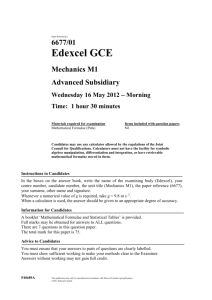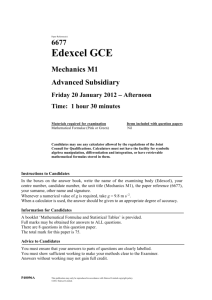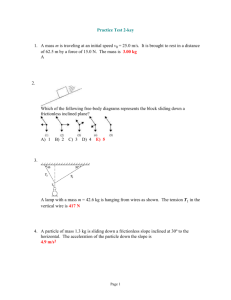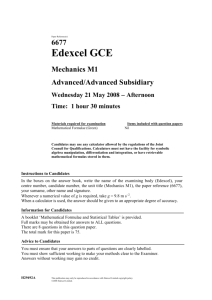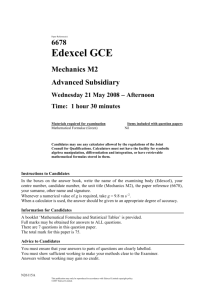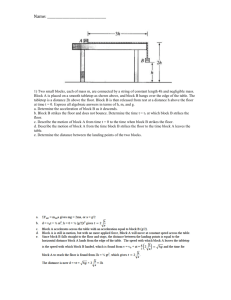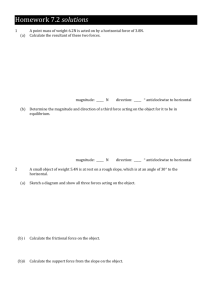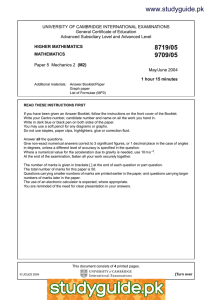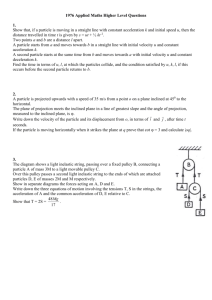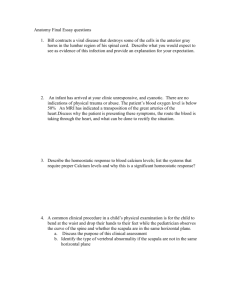May 2013 R - Maths Genie
advertisement
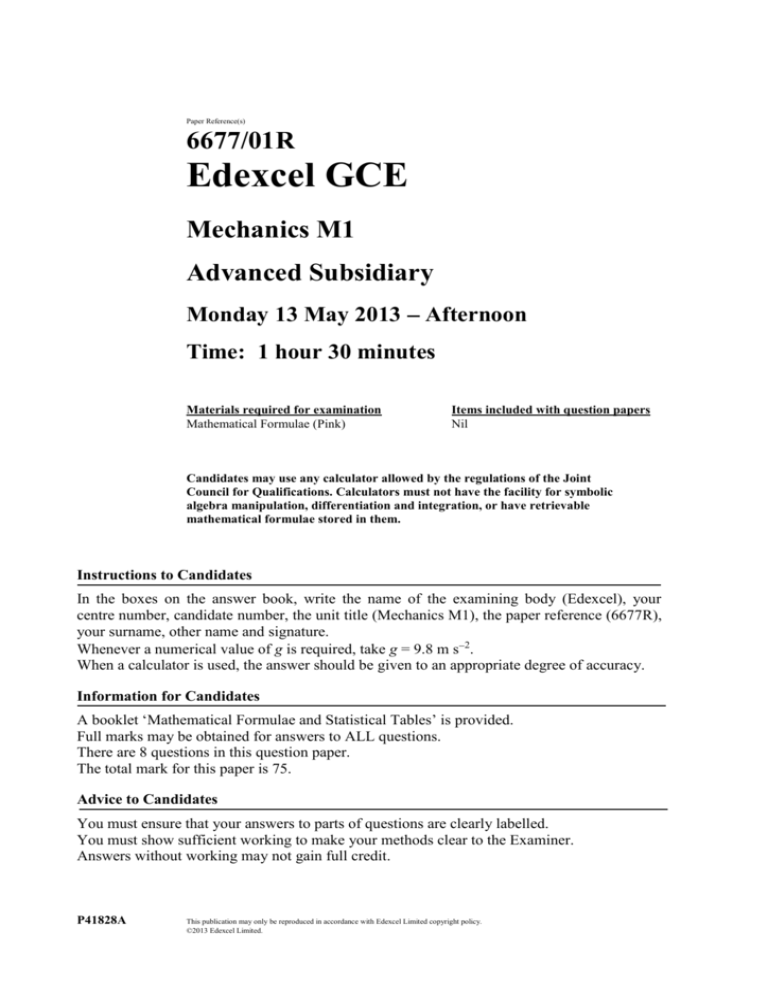
Paper Reference(s) 6677/01R Edexcel GCE Mechanics M1 Advanced Subsidiary Monday 13 May 2013 Afternoon Time: 1 hour 30 minutes Materials required for examination Mathematical Formulae (Pink) Items included with question papers Nil Candidates may use any calculator allowed by the regulations of the Joint Council for Qualifications. Calculators must not have the facility for symbolic algebra manipulation, differentiation and integration, or have retrievable mathematical formulae stored in them. Instructions to Candidates In the boxes on the answer book, write the name of the examining body (Edexcel), your centre number, candidate number, the unit title (Mechanics M1), the paper reference (6677R), your surname, other name and signature. Whenever a numerical value of g is required, take g = 9.8 m s2. When a calculator is used, the answer should be given to an appropriate degree of accuracy. Information for Candidates A booklet ‘Mathematical Formulae and Statistical Tables’ is provided. Full marks may be obtained for answers to ALL questions. There are 8 questions in this question paper. The total mark for this paper is 75. Advice to Candidates You must ensure that your answers to parts of questions are clearly labelled. You must show sufficient working to make your methods clear to the Examiner. Answers without working may not gain full credit. P41828A This publication may only be reproduced in accordance with Edexcel Limited copyright policy. ©2013 Edexcel Limited. 1. Two particles A and B, of mass 2 kg and 3 kg respectively, are moving towards each other in opposite directions along the same straight line on a smooth horizontal surface. The particles collide directly. Immediately before the collision the speed of A is 5 m s–1 and the speed of B is 6 m s–1. The magnitude of the impulse exerted on B by A is 14 N s. Find (a) the speed of A immediately after the collision, (3) (b) the speed of B immediately after the collision. (3) 2. Figure 1 A particle of weight 8 N is attached at C to the ends of two light inextensible strings AC and BC. The other ends, A and B, are attached to a fixed horizontal ceiling. The particle hangs at rest in equilibrium, with the strings in a vertical plane. The string AC is inclined at 35° to the horizontal and the string BC is inclined at 25 to the horizontal, as shown in Figure 1. Find (i) the tension in the string AC, (ii) the tension in the string BC. (8) P41828A 2 3. Figure 2 A fixed rough plane is inclined at 30° to the horizontal. A small smooth pulley P is fixed at the top of the plane. Two particles A and B, of mass 2 kg and 4 kg respectively, are attached to the ends of a light inextensible string which passes over the pulley P. The part of the string from A to P is parallel to a line of greatest slope of the plane and B hangs freely below P, as 1 shown in Figure 2. The coefficient of friction between A and the plane is . Initially A is 3 held at rest on the plane. The particles are released from rest with the string taut and A moves up the plane. Find the tension in the string immediately after the particles are released. (9) 4. At time t = 0, two balls A and B are projected vertically upwards. The ball A is projected vertically upwards with speed 2 m s–1 from a point 50 m above the horizontal ground. The ball B is projected vertically upwards from the ground with speed 20 m s–1. At time t = T seconds, the two balls are at the same vertical height, h metres, above the ground. The balls are modelled as particles moving freely under gravity. Find (a) the value of T, (5) (b) the value of h. (2) P41828A 3 5. Figure 3 A particle P of mass 0.6 kg slides with constant acceleration down a line of greatest slope of a rough plane, which is inclined at 25° to the horizontal. The particle passes through two points A and B, where AB = 10 m, as shown in Figure 3. The speed of P at A is 2 m s–1. The particle P takes 3.5 s to move from A to B. Find (a) the speed of P at B, (3) (b) the acceleration of P, (2) (c) the coefficient of friction between P and the plane. (5) 6. [In this question, the horizontal unit vectors i and j are directed due east and due north respectively.] A ship S is moving with constant velocity (3i + 3j) km h–1. At time t = 0, the position vector of S is (–4i + 2j) km. (a) Find the position vector of S at time t hours. (2) A ship T is moving with constant velocity (–2i + nj) km h–1. At time t = 0, the position vector of T is (6i + j) km. The two ships meet at the point P. (b) Find the value of n. (5) (c) Find the distance OP. (4) P41828A 4 7. Figure 4 A truck of mass 1750 kg is towing a car of mass 750 kg along a straight horizontal road. The two vehicles are joined by a light towbar which is inclined at an angle to the road, as shown in Figure 4. The vehicles are travelling at 20 m s–1 as they enter a zone where the speed limit is 14 m s–1. The truck’s brakes are applied to give a constant braking force on the truck. The distance travelled between the instant when the brakes are applied and the instant when the speed of each vehicle is 14 m s–1 is 100 m. (a) Find the deceleration of the truck and the car. (3) The constant braking force on the truck has magnitude R newtons. The truck and the car also experience constant resistances to motion of 500 N and 300 N respectively. Given that cos = 0.9, find (b) the force in the towbar, (4) (c) the value of R. (4) P41828A 5 8. Figure 5 A uniform rod AB has length 2 m and mass 50 kg. The rod is in equilibrium in a horizontal position, resting on two smooth supports at C and D, where AC = 0.2 metres and DB = x metres, as shown in Figure 5. Given that the magnitude of the reaction on the rod at D is twice the magnitude of the reaction on the rod at C, (a) find the value of x. (6) The support at D is now moved to the point E on the rod, where EB = 0.4 metres. A particle of mass m kg is placed on the rod at B, and the rod remains in equilibrium in a horizontal position. Given that the magnitude of the reaction on the rod at E is four times the magnitude of the reaction on the rod at C, (b) find the value of m. (7) TOTAL FOR PAPER: 75 MARKS END P41828A 6

